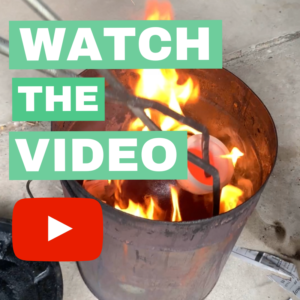Rich Brown recently taught a beginner-level workshop in the clay studio that dove into the art of wheel throwing, with a focus on throwing repetitive forms efficiently while being present and intentional.
The original plan was to take home only bisqueware but…
On the last day, inspired by a desire to bring the wow factor to show and tell, the class decided to add a raku firing, with added expertise from studio assistant Denise Knaggs. “Denise is the glaze master,” said Rich.

Why?
Raku
- is awesome.
- yields stunning results in less time that other glazing methods.
- is a super fun process to learn at Penland.
- allowed this beginner workshop to be very hands on in the firing process
- wowed everyone at show and tell.

Why this pot looks so cool
The glaze you see in this video is a luster glaze mixed by Denise. This specific glaze contains copper and cobalt.
When the lid is put on the bin, oxygen is consumed, creating a reduction chamber. Instead of turning green, the pot becomes a copper color (like a new penny). The part of the pot with the brightest copper color happens where the pot touched the sawdust because it had the least contact with oxygen.
The pot also has a black, satiny rim, caused by the carbon from the sawdust that was absorbed by the porous clay. Raku requires a special clay body that can withstand a temperature shock from 1900 degrees to ambient temperature.

Beginners no longer
We are so impressed by this workshop, who went from beginners to gaining an understanding of how to pull pots beautifully from a fiery kiln with some very long tongs in a matter of seconds, taking into account the specific needs of each glaze, without running into each other.
Congratulations, everyone. It’s safe to say we were all impressed at show and tell!
Special thanks to Denise Knaggs and Taylor Kennedy for assisting.


